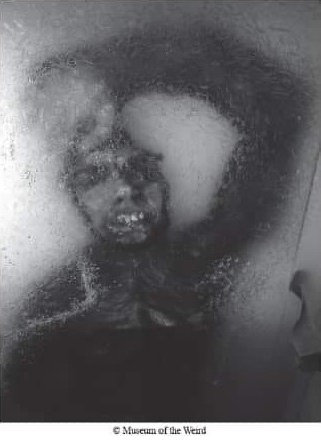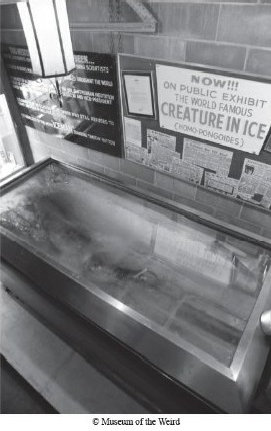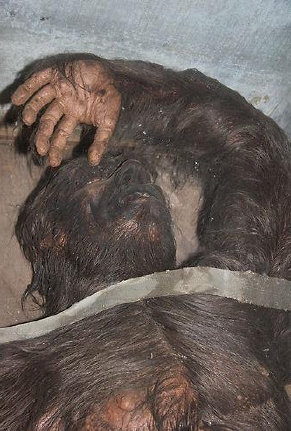

HOME
CONTACT
The Naked Yowie Project


Edited: April 24, 2022
Ken Gerhard: Just one point: If the "original" Iceman and the model on exhibit in Austin are one and the same, with some modifications
made between the time of the "original" and the time of the "model," then, after all these years, I would not expect any odor if the
original odor was owing to animal tissue. Unless the container(s) that it's been in since it was defrosted was/were essentially air
tight, dermestid (carpet beetle) larvae and clothes moth larvae would have consumed all of the animal matter. Also, since Hansen is
reported to have been greatly disturbed by the discovery that the Iceman was emitting a strong odor, he may have removed the offending
tissue.
Ron Pine: You asked if someone on the thread said Hansen was nervous. Hansen said he was nervous - extremely nervous - in the article
he "wrote" for Saga magazine.
"I became extremely nervous when the newspapers in both the U.S. and England pointed out that '... if
this creature is real, then there may be the question of how and why it was killed.'"
Jevning, William. The Minnesota Iceman (Kindle
Locations 649-651). Kindle Edition.
Does William Jevning thinks the Iceman was real?
Daniel Perez: He says at the end he cannot make a decision but this follows a section on the possible different types.
"Personally
I cannot make a decision, however it is possible that if true, then this may represent another type of Undiscovered primate inhabiting
North America."
Jevning, William. The Minnesota Iceman (Kindle Locations 1767-1768). Kindle Edition.
He doesn't know if it was real, but he does know that it will sell yet another one of his Kindle books.
"Mr. Cullen had also mentioned that the frozen monster had a broken skull and that its brains were oozing out at the back. The corpse
was shown to the public as that of a man preserved in ice 'for centuries,' which suggested some great age, even perhaps, with some
imagination, a prehistoric origin."
Heuvelmans, Bernard. NEANDERTHAL: The Strange Saga of the Minnesota Iceman. Anomalist Books. Kindle
Edition.
According to Ken Gerhard above the model's head is intact.
So it was said. Ha ha. Easily faked, or mistaken.
A gaff is meant to be observed, with the intent to fool.
Does the extant whatever really look like this?

Dermestid beetle larvae; along with some other, really minute beetle larvae; and clothes moth larvae can be the bane of museum animal
research collections. They will completely destroy mammal skins and other dried animal materials and pulverise insect collections.
This used to be controlled with pesticides but they've been shown to be carcinigens, so the rooms with the specimens in them are often
kept cool to slow down insect activity and the specimens frequently hard frozen so as to kill any eggs, larvae, pupae, and adults
that might have gotten into the specimens unobserved. The adults will lay eggs along the lid contacts with the specimen cases and
the essentially microscopic newly hatched larvae can get into the cases through those contacts, even though they appear virtually
air tight. However, dermestid beetle larvae are also put to use by museums to clean all the soft tissue off of skeletons. I know of
at least one case in which they were used to clean all of the soft tissue off of a human backbone.
Ron Pine: So no dog tissue remnants to be found on the model because of beetle larvae or because it wasn't there in the first place.
Do
you remember anything else about the letter? Did Sanderson say anything about how he reacted to Hansen's dog tissue story?
Steven
Streufert: The picture I posted is of the exhibit in Austin under ice, or so it appears from the caption. I haven't been to Austin
but maybe someone who has can verify that's what it looks like.Here's another:

Lu... yet another blurry, inconclusive photo?
Steven Streufert: It's what's in the book. Is it not in your copy? I haven't found a good clear picture of the face under ice in Austin.
Maybe Steve Busti could supply one.
My point in asking was to see a decent quality photo rather than the usual Heuvelmans-Sanderson blurry crap.
Steven Streufert: Obviously S&H didn't take those. The full face shot from the translated book is the only one I've found of the
model. All else are in profile, unfrozen. If there's a less blurry one of the front of the model's head under ice I'd like to see
it too.
Stop dancing around the obvious. ALL of the photos suck ass, and fall far short of anything like a scientific presentation. There
is a reason why a sideshow gaff like this is obscured in a case and in ice. It's to obfuscate the truth, and hide the true fakeness
of the thing.
Or, if the original was a real carcass, to try to prevent it from decomposing. The model would have been encased in ice for effect
and to make it look more like the original.
Considering S&H weren't allowed to remove whatever it was from the case I think they
did a pretty good job with photos and drawings. This wasn't a scientific investigation with the thing laid out on an autopsy table
at the Smithsonian. They were guests of Hansen and bound by his "gentleman's agreement", even though they broke it to some extent.
This
shot isn't in profile, but it isn't under ice, either. Still looking.

Lu Ann Lewellen: In regard to the back of the head issues: The wording: "cracked skull," seems odd to me. A merely cracked skull is
not something that would be visible in an actual creature with the soft tissue still present. The back of the head would have had
to have been more profoundly broken up than having a mere "cracked skull," for the brains to have been displaced to the outside of
the head. And a "cracked skull" seems like strange wording for what would have presumably been the exit wound produced by, say, a
bullet from a high-powered rifle. So, a "cracked skull" in this context does seem strange. The appearance of a broken-up back of the
head and material that could be interpreted as loose brains could, of course, have been simulated by materials that could have been
later removed, especially if it involved animal tissue that caused an odor. It seems odd, though, that such fakery would have been
a part of an exhibit that would presumably always consist of a model lying on its "back."
Now an actual creature, of such a size,
imbedded in a block of ice, would have been, I would think, exceedingly heavy, and exceedingly hard to turn over. I read somewhere
that the thing had been placed in the case and then water was poured into the case until it covered the iceman. If so, that also sounds
contrary to the idea that the thing could have been turned over. What were the circumstances of the supposed turning over of the block,
and when and where did it happen? What was Hansen's special motivation to allow such close examination on this occasion but not on
others? If that information is already above and I just missed it in this long thread, forgive me for asking this.
The appearance
of a broken-up back of the head, with escaping brain tissue, could have, of course, been added prior to the thing being turned over
for examination by a close observer, to add extra verisimilitude to a "head" that had supposedly suffered firearm damage, but that
seems like an awful lot of trouble for Hansen to have done, assuming that the reported examination of the rear side did take place
and that the report of what was supposedly seen was accurate. Addition of such materials would have necessitated the thing being turned
over and thawed and refrozen to put the "brain tissue," etc., in place, turning it right-side up again, and then turning it upside
down again in the presence of the observer, and then righting it again. Even if the "brain tissue" had been in place from the beginning,
the thing would have had to have been turned twice to make the close examination of the backside by the observer possible.
Ron Pine: Hansen shaved the ice down. Some of the pictures show it in the case without the case being fully filled with ice. Cullen
saw the exhibit several times at the Wisconsin State Fair.
"Broken skull" and "ice block" were Sanderson's wording.
In the Afterword
Coleman says: "By a strange coincidence, in January 2016, I met Terry Cullen for the first time at the first International Cryptozoology
Conference in St. Augustine, Florida. Cullen confirmed to me that he too felt the real body was switched for a model during the spring
of 1969. He subsequently told me that, contrary to Heuvelmans’ statement, he denies having seen the back of the specimen’s head, saying
only that 'the head seemed to have a saggital crest when viewed through the relatively clear, thin ice that covered the ‘creature’
in his early viewings. So Heuvelmans was incorrect in thinking that 'Cullen was in cahoots with Hansen.'"
Heuvelmans, Bernard. NEANDERTHAL:
The Strange Saga of the Minnesota Iceman. Anomalist Books. Kindle Edition.
But didn't you say something earlier about Coleman? I've
avoided quoting him - until now.
If it was shot through the eye of course the back of the head would be blown out.
I found a Blog Talk
radio Show with Terry Cullen in it but can't get it to play. I was hoping he'd addressed some of theses questions.
Also in the Afterword:
"*
Herpetologist Terry Cullen recalls his viewing of the Iceman: “There were a number of exoskeletons from parasites (likely some kind
of lice) in the body hair. In completely exposed (no ice) areas of the body, one could readily see that each hair had a pore and there
were some pores that did not have hair. Other dermal imperfections/irregularities were also present (dark spots, ‘bumps,’ etc.) that
would argue against a construct. There was a significant amount of blood in the ice and on the skin near the areas of injury (skull).
Some bone could be identified in the injured area. Regarding the damaged eye, one could observe the expected neural and muscular structures
attached or torn. There were what appeared to be vegetative remains lodged in between two of the incisors; the teeth also had mottling
and discoloration. Where they could be observed, toe and fingernails were somewhat ragged and had superficial imperfections. The odor
of corrupted tissue was certainly present when one got very close to the seams in the glass case. The later (post Sanderson/ Heuvelmans)
‘creatures’ were obvious fakes that bore little resemblance to the original.”
Heuvelmans, Bernard. NEANDERTHAL: The Strange Saga of
the Minnesota Iceman. Anomalist Books. Kindle Edition.
Ron Pine: I ask again, do you remember anything else about the dog tissue
letter? Sanderson's take on this revelation, perhaps?
Lu Ann Lewellen: I've several times told all that I remember of Sanderson's letter. If I'd had more, you would have heard about it.
It was received just before the Smithsonian "dropped the ball," it said that Hansen had owned up to Sanderson that the Iceman was
a fake, because of the investigation that had been carried out by the FBI, and explained that the odor, one of the things taken as
most indicative of the Iceman's having been for real, was owing to some rotting dog tissue that had been incorporated into its construction.
As I recall, that is a fair synopsis of the letter, because I don't think that it really contained more information than that. I don't
even recall the letter saying anything additional about how the Iceman was constructed--nothing about latex or bear hair. Napier later
said officially that Sanderson had told him how the Iceman "might have been" constructed. I take this as a euphemistic way of saying
that Sanderson had told him exactly how the real item was constructed according to Hansen. Because of my zoological bent, the dog
tissue business really struck me and became firmly welded to my memory.
As noted just above, I don't remember anything being said
about bear hair. As a mammalogist, I would have certainly remembered that, if it had been said. It would have meant that a taxonomist
could choose between the name Homo pongoides's being a "junior synomym" of the name Canis familiaris or of the name of some species
of bear. Since the exact species of bear, has, as far as I know, never been revealed, the logical choice would be to pick Canis familiaris.
Perhaps Napier got more information from Sanderson as to how the thing was made, in a phone call or some additional correspondence
that Napier didn't share with me.
Ron Pine: Okay, I was hoping there was some indication of whether Sanderson took it seriously or not.
Sanderson was in print about
how he would have gone about constructing a model. It's in the paper he wrote, “Preliminary Description of the External Morphology
of What Appeared to be the fresh corpse of a Hitherto Unknown Form of Living Hominid"
Jevning, William. The Minnesota Iceman (Kindle
Locations 516-517). Kindle Edition.

The whole lot of them... hoaxers.
Lu Ann Lewellen: Even if the ice was "shaved down" somewhat for some reason, a flesh-and blood frozen iceman-sickle would still have
been very heavy and very hard to handle and manipulate. The ice would have been not only heavy but slippery and hard to hold onto.
I'm old enough to remember when there were still quite a few people who didn't have refrigerators but used "iceboxes" to refrigerate
food. For quite a few years after iceboxes had fallen completely out of fashion, there were people who called refrigerators "iceboxes."
There was a building here in town called the icehouse, where you could buy blocks of ice. They had to be handled with big ice tongs,
which bit into the ice. I wonder if Hanson had constructed some sort of rugged windlass with screw-down ice tongs attached, so that
he could lift that mass of ice-cum-Iceman up out of its case and then turn it over and then put it down. There was never any reason
to lift it up and turn it over in the first place, it seems to me, because it was always exhibited on its back. So he wouldn't have
needed to have what I think would be necessary equipment on hand for the lifting and manipulating.
Ron Pine: I would really like to know from Cullen himself what actually transpired. There was an interview with him on a French site
but there was a voice-over in French and I couldn't make out what he was saying. Maybe I can find that again.
Not in a block here apparently.
A couple of straps around it might have done the trick.

Lu Ann Lewellen: I didn't say anything about the possibility of Sanderson's having specifically said whether he thought it was a joke
of Hansen's or a lie or a dream or a vision or a fantasy or whatever, because it was quite clear from Sanderson's tone and choice
of words (although I don't remember what they were) that Sanderson's intent was to tell Napier how the the thing had been made and
that he had accepted Hansen's explanation.
Ron Pine: I was under the impression Sanderson talked about how he would have made it, not how Hansen did. Just where would Hansen
have obtained such things as a clear adult chimpanzee skin and a human skeleton? Hansen had a latex or rubber model made from his
drawings. Several people had a hand in it and there may have been more than one model made. Sanderson would have already run some
of them down and wouldn't have been surprised by the call from the director of the wax museum. Heuvelmans said Sanderson shrugged.








